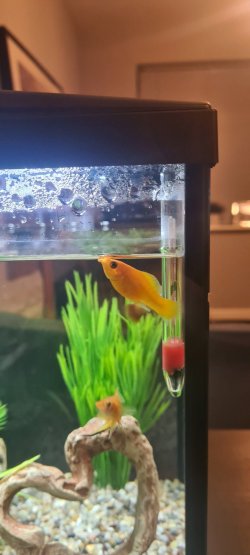Hi and welcome to the forum

Do a 75% water change immediately. Increase aeration/ surface turbulence to maximise the oxygen levels in the water.
Make sure any new water is free of chlorine/ chloramine before it's added to the tank.
The fish is probably suffering from ammonia poisoning as mentioned by others. Ammonia is produced by all fish and anything that rots in the water (fish food, fish waste, dead fish, dead plant, etc). In an aquarium that has a developed biological filter, this ammonia is converted into nitrite and then nitrate, which is less toxic to fish. However, because your tank is newly set up, the filter will not have developed the good bacteria that is needed and you will have ammonia and nitrite problems for the next month.
This is easy to deal with and you will simply be doing a fish in cycle, which means fish are in the tank while the filter cycle occurs. It takes around 6 weeks for the filters to develop the good bacteria. During that time you should reduce feeding to 2-3 times a week. Don't worry, the fish won't starve during this time. You should also do a 75% water change and gravel clean the substrate 4-8 hours after feeding. This big water change dilutes any ammonia that is produced by the fish food and waste.
Make sure any new water is free of chlorine/ chloramine before it is added to the tank.
If you get a liquid test kit, you can monitor the ammonia and nitrite levels as the filter cycles. During the first 2-3 weeks the ammonia levels go up. After a couple of weeks the ammonia level will suddenly drop to 0ppm and the nitrite level will go up. After a couple more weeks, the nitrite level will drop to 0ppm and the nitrate level will start to go up. When this happens, the tank will be cycled.
If you buy a test kit, make sure it is not kept in a brightly lit area, or a warm or humid place. Heat, light and humidity destroy the reagents in the test kits and cause them to break down quicker. You should also check the expiry date on test kits because they go off while sitting on the shelf at the shop. I used to keep my test kits in a plastic bucket with a lid, and this sat on the bottom shelf of my fridge.
*NB* Make sure children and animals can't get the test kits because they contain poisonous chemicals.
After the filter has cycled, you can feed the fish every day and do a 75% water change and gravel clean the substrate once a week.
-------------------
You can buy liquid filter bacteria supplements from most pet shops. These have the good filter bacteria in a plastic bottle and you add some to the tank to help speed up the filter cycling process. I recommend using a double dose every day for a week, then pouring the remaining contents into the tank. Try to add the bacteria supplement near the filter intake so the good bacteria get drawn into the filter where they belong. The filter bacteria supplements can reduce the cycling time by half or even more.
You can also add some floating plants like Water Sprite (Ceratopteris thalictroides/ cornuta) and these will use up some of the ammonia and help keep the water cleaning for the fish. Floating plants will also help reduce algae.




